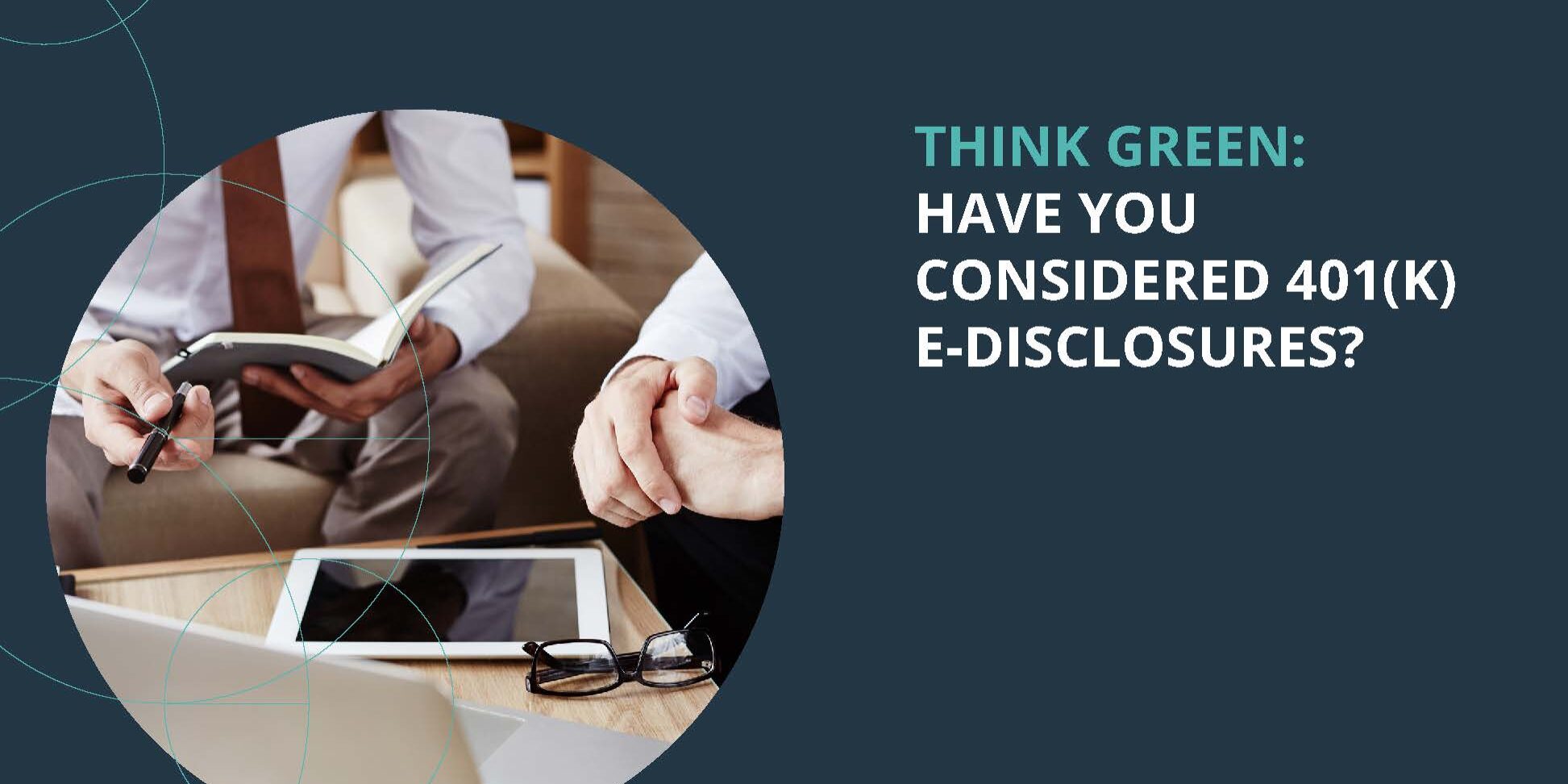Search Posts
Recent Posts
- Video 2021-Q3: 20 Questions To Benchmark Your 401(k) September 14, 2021
- Cycle 3 401(k) Deadline quickly approaching August 31, 2021
- Do You Want to Be Taxed Now or Later? August 17, 2021
- What’s the buzz about PEP, MEPs and SEPs? August 3, 2021
- Plan Sponsor Guide 2021 Q3: Different Types Of Workplace Plans July 20, 2021
Categories
Subscribe!
Thanks for subscribing! Please check your email for further instructions.

Think Green! Have you considered 401(k) e-disclosures?
Anyone who has received stacks of mailed booklets, leaflets or other paper 401(k) disclosure materials might be cheering about the Department of Labor’s (DOL) recent rule that expands employer options for delivering retirement plan documents online.[1]
The Electronic Disclosure Safe Harbor for Retirement Plans went into effect July 27, 2020 as a “voluntary safe harbor for retirement plan administrators who want to use electronic media, as a default, to furnish covered documents to covered individuals, rather than sending potentially large volumes of paper documents through the mail.”[2]
This has many employers “thinking green” and considering a transition to a fully electronic delivery of 401(k) plan disclosure materials, which is also welcome news for many plan participants who are often overwhelmed by the extensive tiny-print disclosures they currently receive as required by ERISA each year.[3]
Going green could save some green
Companies making this transition could see a cost savings. According to the DOL, the move will save approximately $3.2 billion in net costs over the next decade for ERISA-covered retirement plans by eliminating significant materials, printing and mailing costs associated with furnishing printed disclosures.[4]
The DOL also shows that electronic delivery can create “cost savings (that could) ultimately be passed back to participants, translating to lower expenses – and higher net investment returns.”[5]
Additionally, another research study notes that participants may be able to respond quicker to plan information when received electronically because by providing real-time information, it is more accessible, digestible and customizable.[6]
Considerations and helpful information
Here’s what you need to know if you are considering a switch to fully online disclosures.
- Covered individuals. Covered individuals are participants, beneficiaries and others who are entitled to receive covered documents.
- Covered documents. Covered documents are any documents or information that the administrator is required to provide to plan participants and beneficiaries under Title I of ERISA, other than a document or information that needs to be furnished only upon request.
- Eligible materials. Documents and disclosures covered under the new e-delivery rule include, but are not limited to:
- Summary plan description
- Summary of material modification
- Summary annual reports
- Participant-level fee disclosures
- Blackout notices
- Initial notification. Plan administrators must send an initial paper notification that they are changing to the new electronic delivery method, provide the website address and offer the right to opt out if the participant prefers.
- Right to paper. Workers can choose paper copies of specific documents or globally opt out of electronic delivery entirely at any time, free of charge. However, the expectation is that most will likely stay enrolled in the e-disclosure option, especially since an estimated 99% of retirement plan participants have internet access.[7]
- Notifications of Internet Availability (NOIA). Plan administrators must inform participants each time covered documents are posted on the website. Each NOIA must also provide an option for the participant to receive paper copies of notices.
- Website retention. Documents must be accessible online until a newer version is added, but in no event for less than one year.
- System check for invalid electronic addresses. Plan administrators must keep track of the recipient’s email address; and if the address becomes invalid, they must correct the issue or treat the participant as opting out of electronic delivery.
- Employment termination. If an employee leaves the company, the plan administrator must ensure the “continued accuracy and operability of the person’s employer-provided electronic address.”[8]
Under the new rule, the two options for electronic delivery are website posting and email delivery. Plan participants can receive the required notices and disclosures as long as they have access to the information electronically and they are properly notified of any changes.
The move towards an environmentally friendly, more efficient and cost-effective 401(k) disclosure process could be an opportunity for employers to enhance their retirement plan communication with plan participants.
[1]Department of Labor. “Electronic Disclosure Safe Harbor for Retirement Plans.” May 21, 2020.
[2]Department of Labor. “Electronic Disclosure Safe Harbor for Retirement Plans.” May 21, 2020.
[3] Department of Labor. “Employee Retirement Income Security Act (ERISA).” March, 29 2016.
[4]Department of Labor. “Electronic Disclosure Safe Harbor for Retirement Plans.” May 21, 2020.
[5]Department of Labor. “Electronic Disclosure Safe Harbor for Retirement Plans.” May 21, 2020.
[6] Spark Institute. “Improving Outcomes with Electronic Delivery of Retirement Plan Documents.” June 2015.
[7] Spark Institute. “Default Electronic Delivery Works.” November 2019.
[8] Department of Labor. “Electronic Disclosure Safe Harbor for Retirement Plans.” May 21, 2020.
